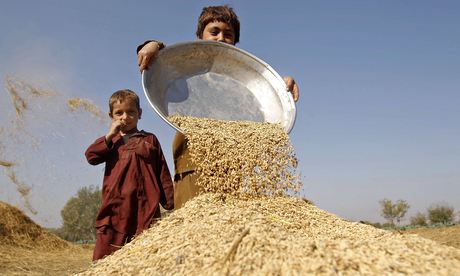Global food security: could wheat feed the world?

How did the international wheat yield partnership come about?
Launched at the Borlaug summit on wheat for food security, held in Mexico on 25 March, the international wheat yield partnership was formed to address rising demand for wheat around the world.
The partnership builds on committments made by agriculture ministers from the G20 nations in 2011 to co-ordinate worldwide research efforts in wheat genetics, genomics, physiology, breeding and agronomy.
The partnership brings together funders and research groups and aims to deliver one of the wheat initiative’s key aims, to increase wheat yield and develop new wheat varieties adapted to different geographical regions.
Why does global wheat production need to be boosted?
Wheat is an important staple crop, providing 20% of all calories consumed by people worldwide. It also makes a significant contribution to animal feed.
Demand for wheat is predicted to increase in the future as the global population increases. With the world’s population estimated to reach 9.6 billion by 2050, wheat production will have a crucial bearing on food security and the global economy in the coming decades. Farmers around the world will need to increase wheat production using constrained resources, like fertilisers, pesticides and water, as the combined factors of climate change and rising energy costs compound the pressures on agriculture.
Good progress has been made towards increasing yields. For example, in 1940, wheat yields in Britain were around 2.5 tonnes per hectare. New varieties and better farming practices introduced during the “green revolution” in the 1960s mean that many farmers can now regularly harvest more than 8 tonnes per hectare today, compared to a worldwide average of about 3 tonnes per hectare.
But the rate of wheat yield increases in developed nations has slowed since 1990 and, given the World Bank’s estimate that global wheat production will have to rise by 60% between 2000 and 2050, this is a major concern.
Politically destabilising wheat price spikes were seen around the world in 2007-8 and 2011 and are likely to occur again if wheat production keeps falling short of demand.
Will increasing monoculture production have negative impacts on biodiversity?
To the contrary; increasing wheat yield means that the land use for wheat does not need to increase.
Wheat is the most widely grown crop in the world. If we can improve and increase yields if could free up areas to devote to other crops, or even land that could be turned back into pasture or used for something else.
The partnership has pledged to secure up to $100m over the next five years from funders and donors worldwide. Where will the money go?
The funding will be put towards increasing the yield potential of wheat in environments all over the world.
Put simply, the best way to do this is to improve wheat’s ability to capture and process the sun’s energy through photosynthesis, and to make sure that the captured carbon ends up in the grain of wheat.
A mixture of fundamental bioscience and applied research will be needed to deliver this on a grand scale. The partnership will combine these in a focused research programme to develop new technology, knowledge, models and wheat breeds suited to diverse environments.
What impact will it have on global food security, and development more broadly?
Meeting the growing demand for wheat, as one of the world’s most important staple crops, would significantly boost food security in developing countries across the world.
Developing improved wheat breeds, species and technologies will also make wheat production easier and cheaper for farmers in the developing world – and so give them better access to markets.
Continued progress in wheat development, and ensuring it has the best possible impact on development, will depend on international public-private partnerships, good communication and best-practice sharing between all groups working to boost wheat production.
Collected:
http://www.theguardian.com/

